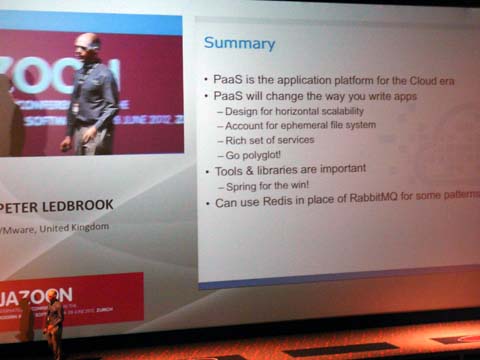Methods & Tools is a media partner of Jazoon and I spent one day in Zurich assisting to this conference that has an attendance over 450 people coming from more than 25 countries. Although its original focus was on Java and still keeps a lot of its content around this technology, there are a lot of presentations on other topics like the Cloud, mobile apps or agile software development.
The Tuesday morning keynote was given by Dave Thomas with a title “Development Next – And Now for Something Completely Different?”. He was the founder and CEO of Object Technology International, Inc (OTI) which was responsible for initial development of the Eclipse open source IDE. He delivers in a lively and sarcastic speech his vision of the current state and the future of software development. He believes that the future is in functional programming but thinks that “everybody who is on top of new languages today probably isn’t writing any code”. He thinks that Lean values are the more important factor to change software development and Agile is only there to help. He doesn’t like the certification process and the fact that some corporations measure their agility by counting their CSM (Certified ScrumMaster).
Next, I attended a presentation about migrating a web application to Cloud Foundry. Peter Ledbrook makes it clear that applications will have better to move to a service oriented and message based architecture if they want to migrate more easily to the web. So many things are different in the Cloud when you have multiple instances and different support for technologies that you need to isolate each function of your application to make it easier to adapt.

Tudor Girba gave an interesting speech on software assessment, which he defines as the time spent reading and understanding code or another part of a system like a log or configuration file. A developer might spend 50% of his time doing this, so he recommend that organizations invest in tools to help handling this activity and to achieve better decisions.
In his “Death by dogma versus assembling agile” presentation, Sander Hoogendoorn said that too many organizations are starting Agile with inexperienced ScrumMaster (how can you be certified after attending a two day class?) who will be applying Agile dogmatically as a set of rituals rather than be inspired by its values. He used his experience of Agile coach to give examples of dogmatic Agile in situation like creating the backlog, documentation, the requirements format or organizations starting to write “Agile Handbooks”. His conclusion is that any project should start by assembling the approach that best fits in its context. Interesting note: people always blame the methodology for the failures of “waterfall” projects and the people for the failures of “agile” projects.
Jutta Eckstein talked about implementing Agile in large corporations and the specific challenges met in legal issues, establishing trust and transparency, managing by budgets. She remembers us that we cannot change organizations, but only the individuals that compose them.
Finally, two QSM consultants shared some numbers on the productivity assessed on some Agile projects, showing that it was not better than traditional projects. But as they said, “knowing the answer means nothing”. The best part of their presentation was showing how to use their model to see how changing the factors (pressure to market, scope and team productivity) can influence the cost and duration of projects. In an ideal world, each developed feature will have a monetary benefit attached and you could therefore aim for some optimal schedule using a cost/benefit approach.
